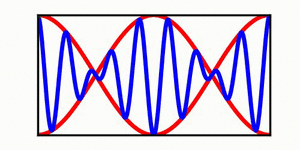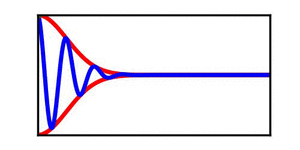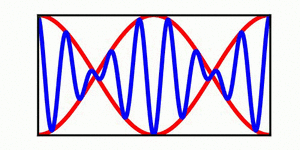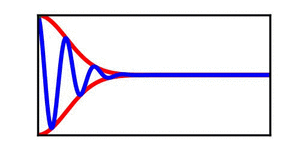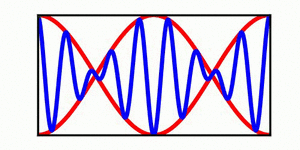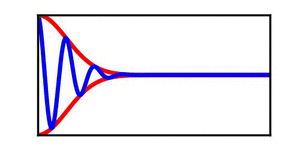Wave Envelope: Difference between revisions
| Line 10: | Line 10: | ||
The linear KdV equation is <math>\frac{\partial}{\partial t}\eta+c\frac{\partial}{\partial x}\eta + \beta\frac{\partial^3}{\partial x^3}\eta = 0</math>. Using the method of multiple scales, suppose that the wave envelope evolves on slower temporal and spatial scales than the wave crests. Denote the slower scales by <math>(\tau,\chi)=(\epsilon t,\epsilon x)</math>, for <math>0<\epsilon\ll1</math>, and separate using <math>\eta=A(\tau,\chi)\phi(x,t)</math>. After substituting into the KdV equation, the equation becomes: | The linear KdV equation is <math>\frac{\partial}{\partial t}\eta+c\frac{\partial}{\partial x}\eta + \beta\frac{\partial^3}{\partial x^3}\eta = 0</math>. Using the method of multiple scales, suppose that the wave envelope evolves on slower temporal and spatial scales than the wave crests. Denote the slower scales by <math>(\tau,\chi)=(\epsilon t,\epsilon x)</math>, for <math>0<\epsilon\ll1</math>, and separate using <math>\eta=A(\tau,\chi)\phi(x,t)</math>. After substituting into the KdV equation, the equation becomes: | ||
<math>A\phi_t + \epsilon A_{\tau}\phi + cA\phi_x + \epsilon cA_{\chi}\phi + \beta\left(A\phi_{xxx} + 3\epsilon A_{\chi}\phi_{xx} + 3\epsilon^2 A_{\chi\chi}\phi_{x} + \epsilon^3 A_{\chi\chi\chi}\phi \right) = 0</math>, where subscripts denote derivatives. | <math>A\phi_t + \epsilon A_{\tau}\phi + cA\phi_x + \epsilon cA_{\chi}\phi + \beta\left(A\phi_{xxx} + 3\epsilon A_{\chi}\phi_{xx} + 3\epsilon^2 A_{\chi\chi}\phi_{x} + \epsilon^3 A_{\chi\chi\chi}\phi \right) = 0</math>, where subscripts denote partial derivatives. | ||
===== <math>\mathcal{O}(1)</math> Problem: ===== | ===== <math>\mathcal{O}(1)</math> Problem: ===== | ||
Revision as of 13:51, 2 June 2015
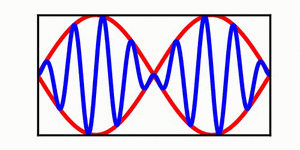
A simple demonstration of the distinction between a wave envelope and individual wave crests. The red curves depict the wave envelope, while the blue curve indicates the individual wave crests (in the context of a surface wave, the blue curve can be viewed as the water surface). The blue curve is not propagating while the red curve is steadily propagating to the right, highlighting the distinction between the propagation of an individual wave crest.
A table is included below that demonstrates three different cases: envelope propagation faster than crest propagation, envelope propagation equal to crest propagation, and envelope propagation slower than crest propagation. Both a continuous wave train and a single wave packet are shown.
Derivation using KdV
The linear KdV equation is . Using the method of multiple scales, suppose that the wave envelope evolves on slower temporal and spatial scales than the wave crests. Denote the slower scales by , for , and separate using . After substituting into the KdV equation, the equation becomes: , where subscripts denote partial derivatives.
Problem:
Assuming that , the first order problem is found to be . If a plane-wave solution of is taken, then the problem reduces to . This gives the dispersion relation for the linear problem.
Problem:
Again assuming that , the first order problem is found to be . As a result, , showing that the propagation speed of the wave envelope is given by . In particular, .







![{\displaystyle \left[{\frac {\partial }{\partial t}}+c{\frac {\partial }{\partial x}}+\beta {\frac {\partial ^{3}}{\partial x^{3}}}\right]\phi =0}](https://wikimedia.org/api/rest_v1/media/math/render/svg/b892792ea15656ff512d07c737dbe4af5494fd7b)



![{\displaystyle \left[{\frac {\partial }{\partial \tau }}+\left(c-3\beta k^{2}\right){\frac {\partial }{\partial \chi }}\right]A=0}](https://wikimedia.org/api/rest_v1/media/math/render/svg/248727a65df7455190008d053c6893cc488df328)




